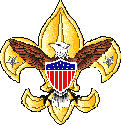| MERIT BADGES |
|
|
|
|
| Note: Eagle Required are in Italics |
"A"
American
Business
American Culture
American Heritage
American Labor
Animal Science
Archaeology
Archery
Architecture
Art
Astronomy
Athletics
Atomic Energy
Auto Mechanics
Aviation
"B"
Backpacking
Basketry
Bird Study
Bugling
"C"
Camping
Canoeing
Chemistry
Cinematography
Citizenship
Community*
Citizenship Nation*
Citizenship World*
Climbing
Coin Collecting
Collections
Communications*
Computers
Cooking
Crime Prevention
Cycling*
"D"
Dentistry
Disability Awareness
Dog Care
Drafting
"E"
Electricity
Electronics
Emergency
Preparedness**
Energy
Engineering
Entrepreneurship
Environmental
Science*
"F"
Family Life*
Farm Mechanics
Fingerprinting
Fire Safety
First Aid*
Fish & Wildlife Mgmt.
Fishing
Fly Fishing
Forestry
"G"
Gardening
Genealogy
Geology
Golf
Graphic Arts
"H"
Hiking
Home Repairs
Horsemanship
"I"
Indian Lore
Insect Studies
"J"
Journalism
"K"
"L"
Landscape Architecture
Law
Leatherwork
Lifesaving**
"M"
Mammal Study
Medicine
Metalwork
Model Design & Building
Motorboating
Music
"N"
Nature
"O"
Oceanography
Orienteering
"P"
Painting
Personal Fitness**
Personal Management*
Pets
Photography
Pioneering
Plant Science
Plumbing
Pottery
Public Health
Public Speaking
Pulp and Paper
"Q"
"R"
Radio
Railroading
Reading
Reptile & Amphibian Study
Rifle Shooting
Rowing
"S"
Safety
Salesmanship
Scholarship
Sculpture
Shotgun Shooting
Skating
Skiing
Small Boat Sailing
Soil & Water
Conservation
Space Exploration
Sports**
Stamp Collecting
Surveying
Swimming**
"T"
Textile
Theatre
Traffic Safety
Truck Transportation
"U"
"V"
Veterinary Medicine
"W"
Water Skiing
Weather
Whitewater
Wilderness Survival
Wood Carving
Woodwork
"X"
"Y"
"Z"
 Coin Collecting
Coin CollectingRequirements 1975 |
- Do these:
- Collect a type set of U.S. coins of any year currently being minted or in circulation. Commemorative, proof, silver, rare, or expensive coins are not needed. Have at least one coin from each mint in your type set.
- In your type set, point out and identify the mint mark (if any) on each coin. Tell when each mint first started making coins.
- For each coin in your type set, point out the location on the initials (if any) of each coin's designer(s).
- Do these:
- Tell about the various grades of coins. Show six examples.
- Tell what buffed and whizzed coins are. Tell how to detect them.
- Do ONE of the following:
- Tell how to detect counterfeit coins.
- Tell how to properly clean coins.
- Do TWO of the following:
- Make enlarged sketches of both sides of five different kinds of U.S. coins minted from 1792 through the present year. Make sketches of both sides of five different colonial or state coins minted before 1792. Show designs, dates, and lettering clearly.
- Collect, classify, and mount 50 different coins of 10 different countries.
- Collect a type set of U.S. coins minted during the 20th century (except commemorative, proof, gold, rare, or expensive coins).
- Collect a set of some U.S. series of coins beginning with your year of birth (except for rare or expensive coins).
- Collect, classify, describe, and mount 10 medals, tokens, or combination of both. Have three different size medals or tokens and three different metals or compositions in the collection.
- Show the location of and explain the following on a current piece of U.S. paper money:
- the Federal Reserve Bank and letter,
- serial number,
- series,
- check letter,
- face plate number,
- back plate number,
- seal and seal color,
- signatures,
- denomination.
Describe three things to look for in detecting counterfeits.
|
||||||
Last Update May 15, 2023

.jpg)
